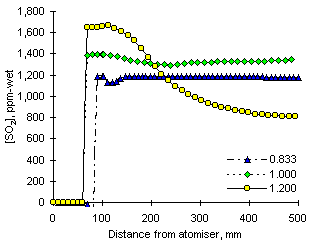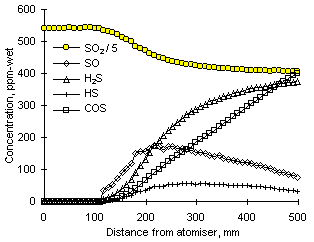
Figure 120: Calculated concentrations of SO2 from fuel M1 in air at three equivalence ratios

The concentrations of SO2 calculated by the numerical model, although 10 % lower on average in the case of fuel M1, showed satisfactory agreement with those obtained experimentally, especially in the case of fuel G1. This can be seen by comparing Figures 64 and 65, and Figures 120 and 121.
Since the reactions that lead to the conversion of H2S into SO2 are very rapid when oxygen is still available, the concentrations of sulphur dioxide are large from the very early stages of the combustion process.
The PFR zone exerts varying effects on the concentrations of SO2, according to the equivalence ratio. In fuel-lean conditions, they remain unchanged. Slight changes are observed at  = 1.000, whereas in fuel-rich conditions the concentration of sulphur dioxide decreases as the distance from the atomiser (ie, the residence time) increases.
= 1.000, whereas in fuel-rich conditions the concentration of sulphur dioxide decreases as the distance from the atomiser (ie, the residence time) increases.

When calculations were performed with the simulated composition of fuel G1, the reduction of SO2 in fuel-rich conditions was more pronounced, as seen in Figure 121. This fuel had a lower sulphur content (1.74 % by weight) than M-013/95 (3.59 % by weight).
The reduction of SO2 in fuel-rich conditions was also observed in the experimental work performed in the drop-tube furnace, and it is reported in section "4.4.4. SO2" of chapter III.

Results from the numerical model confirm that the disappearance of SO2 under fuel-rich conditions runs parallel to the increase of reduced sulphur species, such as SO, H2S, HS and COS. Although SO2 remains as the predominant sulphur compound, eventually the concentrations of COS and H2S become relevant whilst those of other sulphurous species decay in time. This can be seen in Figure 122. COS is formed via the reaction of CO and S, whereas H2S is formed through a much more complex series of reactions involving several sulphurous species.
Under fuel-rich conditions the concentrations of NO2 are low, as seen in the previous section; thus the reaction between NO2 and SO2 may not be responsible for the disappearance of sulphur dioxide.
 Previous |  Table of Contents |  Next |